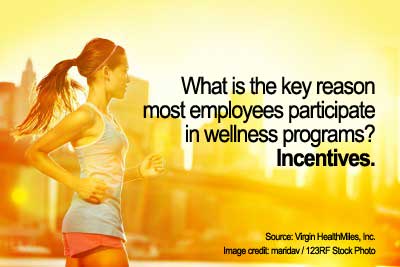A recent U.S. Department of Labor report found most employers (92 percent) with 200 or more employees offer wellness programs, with the bulk of these programs addressing exercise, smoking, and weight loss. Actual employee participation, however, is another story. Less than one-fourth of employees who can participate actually do. In the midst of National Employee Wellness Month, our friends at Blue Cross Blue Shield of Texas (BCBSTX) weigh-in with advice to help you beat these odds. Their first tip is surprisingly ironic (coming from one of the largest corporate health insurance providers in Texas): Ditch the corporate approach and keep things fresh.
“There are a lot of effective ways to engage employees in wellness programs. As with many situations, one size does not truly fit all,” says Dan K. McCoy, MD, vice president and chief medical officer at BCBSTX. “Each person has a unique personality and is motivated in different ways. Employers must keep this in mind.”
“An important consideration is to keep communications fun and to avoid the traditional corporate format when possible,” adds David Dahlke, Sr. Manager of Motiva Wellness, BCBSTX’s own internal employee wellness program.
Does your tired old employee wellness program need a facelift? Two trends in customizing and refreshing an employee wellness program are adding incentives and digital engagement.
Incentivize it. In a recent Aon study, almost half of employers with reward-based incentives reported a positive impact on employee morale, satisfaction and/or attitudes, and 44 percent saw changes in health risks. More than 60 percent of employees participating in a Virgin HealthMiles, Inc. survey admitted that incentives are the key reason they take part in employee wellness programs.
“As a general rule, incentives work very well when trying to impact employees’ lifestyles and behaviors,” says Dr. McCoy. “These types of incentives are most powerful when they have a meaningful value to your employees.”
 An interesting—albeit controversial—trend is mixing rewards for participants with consequences for non-participants. The same Aon study concluded that while most companies still offer rewards only (nearly 80 percent), a growing 16 percent mix rewards with consequences. This “carrots” versus “sticks” plot (as coined by Health Policy Briefs) will thicken in 2014, when the Affordable Care Act of 2010 expands employers’ ability to monetarily reward employees who meet health status goals by participating in wellness programs. Thus, employers will have the right to in-effect “penalize” non-participating employees by charging them more for employer-sponsored health coverage.
An interesting—albeit controversial—trend is mixing rewards for participants with consequences for non-participants. The same Aon study concluded that while most companies still offer rewards only (nearly 80 percent), a growing 16 percent mix rewards with consequences. This “carrots” versus “sticks” plot (as coined by Health Policy Briefs) will thicken in 2014, when the Affordable Care Act of 2010 expands employers’ ability to monetarily reward employees who meet health status goals by participating in wellness programs. Thus, employers will have the right to in-effect “penalize” non-participating employees by charging them more for employer-sponsored health coverage.
“If you’re trying to encourage an employee to make a choice, then disincentives can be motivational,” Dr. McCoy explains. “For example, when smokers are given a surcharge for using tobacco, they are generally motivated to drop the habit.”
Digitize it. Another way to transform an employee wellness program is to engage employees with digital components: gamification, mobile technology, and social media. What’s gamification, you ask? It’s the process of using quizzes, contests, point systems or other game-like elements to spearhead participation. Gamification is an age-old tactic that’s getting an immense boost, thanks to technology. WorldatWork and Buck Consultants studied the impact of digital gamification on employee wellness programs recently and came to a few eye-opening conclusions. Among the employers surveyed:
- Gamification is the most prevalent engagement tool (at 62 percent), ranking highest in respondents’ perception of effectiveness, above mobile technology (36 percent) and social media (50 percent).
- Only 12 percent report using online or mobile games today, but 52 percent are considering adopting such features within the next three years.
- Sixty percent use contests for health engagement, such as weight loss or walking competitions.
- More the 60 percent felt gamification was effective in improving specific health/lifestyle behaviors among participants.
Austin, TX, based MapMyFitness is helping to pioneer the art of digital engagement for wellness initiatives. The company (with flagship products MapMyRide and MapMyFitness) uses GPS technology to provide users the ability to map, record, and share exercise routes and workouts. Touted as “connected health”, MapMyFitness aims to spur engagement in leaderboards and virtual challenges as a means to informally engage friends and colleagues in a little “healthy” competition.
The Austin Diagnostic Clinic (ADC) recently strengthened its own employee wellness program with digital engagement through Virgin Healthmiles, “We felt this was a great way to help our wellness program participants own the program,” says Cindy Brummer, website designer and content manager at ADC. “They receive emails about national challenges, ADC challenges, and reminders. Plus, they can access the program from anywhere. I feel it’s helping our employees make connections with colleagues [who] work at different locations or in different departments. But I also think it strengthens the relationships within departments. We’ve seen large groups from departments show up for bio-metric screening because of the program.”
We’d love to hear what’s working for you. Have you recently added an incentive program or digital features to your employee wellness program? Tell us about it in the comments below!
Image credit: bowie15 / 123RF Stock Photo



